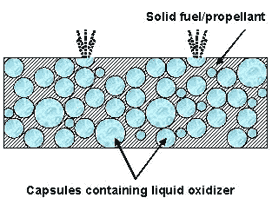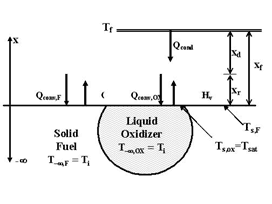Students: Yoash Mor
Former Students: Dr. Avishag Pelosi, Avishay Setter, Or Livne
Supervisor: Prof. Alon Gany
The extreme simplicity of solid propellant motors makes them attractive and suitable for multiple purposes. Yet, their relatively low energetic performance, stemming from the poor energetic potential of solid oxidizers, yields the need for more energetic propellant formulations. Over the past 15-20 years, a significant effort has been concentrated on the search for new high energy materials in the field of solid propellants/explosives, leading to the development of some interesting oxidizer formulations, e.g. ammonium dinitramide (ADN), hexanitro hexaza isowurtzitane (CL-20) and hydrazinium nitro formate (HNF), as well as high energy binders such as glycidyl azide polymer (GAP), bis azido methyl oxetane (BAMO) and more. However, their application is still conditioned and entangled by their complicated and high cost synthesis, as well as by their explosive nature. Another way to enhance the performance of solid propellant motors is the use of a liquid oxidizer instead of a solid one. This is achieved in hybrid propulsion, where an oxidizer (gas or liquid spray) flows and burns within a solid fuel grain port.
In this work, a novel micro-hybrid combustion configuration is proposed, where liquid oxidizer capsules are embedded in a binder/propellant matrix, just as in conventional propellants solid oxidizer particles are contained in the polymeric binder. In the macro-scale, thermochemical calculations show that an optimal combination of a polymeric fuel (e.g. HTPB), aluminum and a liquid oxidizer, can theoretically increase the heat of combustion by 10%-20%, implying a potential enhancement of the specific impulse by 6% to 12% over conventional solid propellants.
The study focuses on a miniature “hybrid” configuration, considering the combustion in the micro-scale of a single oxidizer droplet contained in a solid binder matrix. A mathematical analysis is suggested, based on experimentally observed phenomena and physical considerations. In the micro-scale, similarity to combustion of a solid oxidizer particle surrounded by a solid fuel matrix may be postulated, yielding the formulation of a one-dimensional model, which describes the main characteristics of the flamelet formed by a volatile (typically polymeric) fuel component and an evaporating oxidizer, at sub-critical and supercritical pressure operation. The model predicts fuel and oxidizer surface temperatures, fluxes and flame standoff distance as a function of operating pressure and droplet size. The transient nature of the combustion process is emphasized, revealing a combustion cycle at the individual droplet scale, with pressure-dependent average burning rates typical to solid propellants. An experimental study focuses on the observation of the phenomena involved in the combustion of a fuel-rich solid propellant strand containing a liquid oxidizer droplet/column. Interesting combustion features (oxidizer boiling, flame structure, surface irregularity) are qualitatively observed, and the pressure-dependent average regression rate of the “hybrid” strand is measured and compared to the regular fuel-rich propellant one.
The work presents a fundamental innovation and original results, providing theoretical and experimental aspects of the unexplored features of a micro-scale hybrid combustion process.
 |
 |
References
- Pelosi, A.D. and Gany, A., “Combustion of a Solid Fuel Tube with Contained Liquid Oxidizer in a Hot Gas Atmosphere”, Combustion Science and Technology, Vol. 179, 2007, pp. 265-280.
- Pelosi, A.D. and Gany, A., “Experimenting and Modeling the Combustion of a Liquid Oxidizer with Adjacent Solid Fuel”, AIAA Paper 2006-4929, 42nd AIAA/ASME/ SAE/ASEE Joint Propulsion Conference, Sacramento, CA, USA, July 9-12, 2006.
- Pelosi, A.D. and Gany, A., “The Mechanics Involved in the Combustion of a Liquid Oxidizer Capsule Contained in a Solid Fuel”, 7th International Symposium on Special Topics in Chemical Propulsion (7-ISICP), Kyoto, Japan, Sept. 17-21, 2007.

